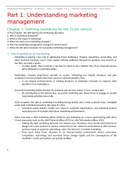Marketi ng Management – Summary – Part 1: Chapter 1 & 2 – Pauline Vandenbroucke – 2021/2022
Part 1: Understanding marketing
management
Chapter 1: Defining marketing for the 21ste century
In This Chapter, We Will Address the Following Questions
1. Why is marketing important?
2. What is the scope of marketing?
3. What are some core marketing concepts?
4. How has marketing management changed in recent years?
5. What are the tasks necessary for successful marketing management?
1. The importance of marketing
- Marketing is playing a key role in addressing those challenges. Finance, operations, accounting, and
other business functions won’t really matter without sufficient demand for products and services so
the firm can make a profit.
o In other words, there must be a top line for there to be a bottom line. Thus, financial success
often depends on marketing ability.
- Marketing’s broader importance extends to society. Marketing has helped introduce and gain
acceptance of new products that have eased or enriched people’s lives.
o It can inspire enhancements in existing products as marketers innovate to improve their
position in the marketplace.
- Successful marketing builds demand for products and services, which, in turn, creates jobs.
o By contributing to the bottom line, successful marketing also allows firms to engage in socially
responsible activities more fully.
- CEOs recognize the role of marketing in building strong brands and a loyal customer base, intangible
assets that contribute heavily to the value of a firm.
o Consumer goods makers, health care insurers, nonprofit organizations, and industrial product
manufacturers all trumpet their latest marketing achievements.
- Many now have a chief marketing officer (CMO) to put marketing on a more equal footing with other
C-level executives such as the chief financial officer (CFO) or chief information officer (CIO).
o Making the right marketing decisions isn’t always easy. Marketers must decide what features to
design into a new product or service, what prices to set, where to sell products or offer services,
and how much to spend on advertising, sales, the Internet, or mobile marketing.
o They must make those decisions in an Internet-fueled environment where consumers,
competition, technology, and economic forces change rapidly, and the consequences of the
marketer’s words and actions can quickly multiply.
1
,Example Domino’s:
o Dominos learned an important lesson about PR and brand communications in a modern era.
o As Domino’s learned, in an era of connectivity, it is important to respond swiftly and decisively.
While marketers were coming to grips with this increasingly wired world, the economic
recession of 2008–2009 brought budget cuts and intense pressure from senior management to
make every marketing dollar count. More than ever, marketers need to understand and adapt
to the latest marketplace developments. At greatest risk are firms that fail to carefully monitor
their customers and competitors, continuously improve their value offerings and marketing
strategies, or satisfy their employees, stockholders, suppliers, and channel partners in the
process.
o Skillful marketing is a never-ending pursuit.
o Consider how a top firm drive business:
Johnson & Johnson launched BabyCenter.com to help new parents. Its success is
thought to have contributed to subscription slumps experienced by parenting
magazines. Good marketers are always seeking new ways to satisfy customers and beat
competition.
2. What is marketing Management
- Marketing is about identifying and meeting human and social needs. One of the shortest, good
definitions of marketing is “meeting needs profitably.”
o When eBay recognized that people were unable to locate some of the items they desired most,
it created an online auction clearinghouse. When IKEA noticed that people wanted good
furnishings at substantially lower prices, it created knockdown furniture. These two firms
demonstrated marketing savvy and turned a private or social need into a profitable business
opportunity.
- The American Marketing Association offers the following formal definition:
o Marketing is the activity, set of institutions, and processes for creating, communicating,
delivering, and exchanging offerings that have value for customers, clients, partners, and
society at large. Coping with these exchange processes calls for a considerable amount of work
and skill.
o Marketing management takes place when at least one party to a potential exchange thinks
about the means of achieving desired responses from other parties.
Thus we see marketing management as the art and science of choosing target markets
and getting, keeping, and growing customers through creating, delivering, and
communicating superior customer value.
- We can distinguish between a social and a managerial definition of marketing.
o A social definition shows the role marketing plays in society; for example, one marketer has said
that marketing’s role is to “deliver a higher standard of living.” Here is a social definition that
serves our purpose:
2
, -
Marketing is a societal process by which individuals and groups obtain what they need and want
through creating, offering, and freely exchanging products and services of value with others.
o Managers sometimes think of marketing as “the art of selling products,” but many people are
surprised when they hear that selling is not the most important part of marketing! Selling is
only the tip of the marketing iceberg. Peter Drucker, a leading management theorist, puts it this
way:
o The aim of marketing is to know and understand the customer so well that the product or
service fits him and sells itself. Ideally, marketing should result in a customer who is ready to
buy. All that should be needed then is to make the product or service available.
Example Ikea
- Getting, keeping, and growing
- Keep quality high, adjust to the country/region (adapt the products and rooms to the need of the
people)
o Membership card (ikea family card)
o Cheap food
o Magazine every month/year
- Creating, delivering, and communicating
o Delivery @ home
o Social media / billboards
o Important partners
o Vouchers
o Advertising / sponsoring events
- Superior customer value
o A full-day-experience
o Food after shopping, cheap
o Delivery @ home
- Target markets
o Beginning schoolyear students younger people
o New family’s new house (not that expensive / affordable)
3. What can be marketed?
- Marketer’s market 10 main types of entities: goods,
services, events, experiences, persons, places,
properties, organizations, information, and ideas.
Let’s take a quick look at these categories.
GOODS
- Physical goods constitute the bulk of most countries’ production and marketing efforts.
SERVICES
- As economies advance, a growing proportion of their activities focuses on the production of services.
Services include the work of airlines, hotels, car rental firms, barbers and beauticians, maintenance and
repair people, and accountants, bankers, lawyers, engineers, doctors, software programmers, and
management consultants. Many market offerings mix goods and services, such as a fast-food meal.
3





